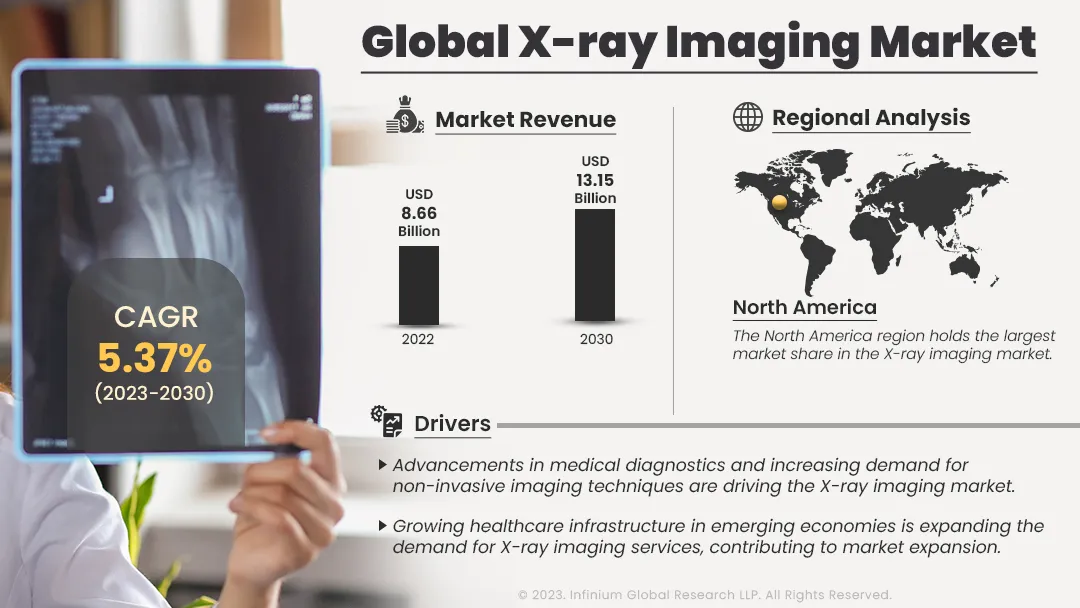X-ray Imaging Market (Portability - Stationary, and Portable; Technology - Analog, and Digital; Application - Orthopaedic, Chest, Dental, and Mammography; End User - Diagnostic Center, and Hospital): Global Industry Analysis, Trends, Size, Share and Forecasts to 2030
A recent report published by Infinium Global Research on X-ray imaging market provides in-depth analysis of segments and sub-segments in the global as well as regional X-ray imaging market. The study also highlights the impact of drivers, restraints, and macro indicators on the global and regional X-ray imaging market over the short term as well as long term. The report is a comprehensive presentation of trends, forecast and dollar values of global X-ray imaging market.
Market Insight:
X-ray imaging, also known as radiography, is a medical imaging technique that uses X-ray radiation to create detailed images of the inside of the human body. It is a non-invasive and widely used diagnostic tool that helps healthcare professionals visualize the internal structures of bones and organs. Additionally, the scope of X-ray imaging is in the detection and diagnosis of bone fractures and injuries. It is highly effective in assessing the integrity of the skeletal system, allowing healthcare providers to identify fractures, dislocations, and other bone-related abnormalities. X-rays are also crucial in guiding the treatment and monitoring the healing process of these injuries. Moreover, they are essential in orthopedic surgeries, helping surgeons plan and execute procedures with precision. Beyond fractures, X-ray imaging is valuable in the diagnosis of a variety of conditions, such as lung infections, dental problems, and certain gastrointestinal disorders, making it an indispensable tool in modern medicine for both diagnosis and treatment planning.
Advances in medical diagnostics, such as digital X-ray technology, and the growing demand for non-invasive imaging methods are propelling the X-ray imaging market. These innovations improve image quality, reduce radiation exposure, and enhance the accuracy of diagnoses. The increasing need for rapid and effective medical imaging is fueling market growth. Additionally, the expansion of healthcare infrastructure in emerging economies is amplifying the demand for X-ray imaging services. This surge in demand is a significant driver for the X-ray imaging market, as it leads to increased accessibility to diagnostic services, improved patient care, and higher adoption of X-ray technology across various healthcare settings. However, apprehensions about radiation exposure and associated risks can impede the widespread adoption of X-ray imaging, particularly in cases where alternative imaging methods with lower or no radiation are available and deemed safer. These concerns may restrict the market's growth, prompting the exploration of alternative diagnostic modalities. Although, technological advancements like digital radiography and 3D imaging offer substantial growth prospects in the X-ray imaging market. These innovations enhance diagnostic accuracy, reduce radiation exposure, and improve overall imaging capabilities, driving increased adoption and fostering opportunities for market expansion.

The North America region holds the largest market share in the X-ray imaging market. This is primarily attributed to factors such as advanced healthcare infrastructure, high healthcare spending, a well-established regulatory framework, and a significant focus on technological innovation. The United States, in particular, is a major contributor to this region's supremacy, with a robust healthcare sector and continuous investments in medical imaging technologies. Moreover, the Asia-Pacific region is the fastest-growing region in the X-ray imaging market. Emerging economies such as China and India are witnessing substantial growth due to increasing healthcare investments, a growing population, and rising awareness about the benefits of medical imaging. Additionally, there's a trend towards modernizing healthcare facilities, and the demand for non-invasive diagnostic methods is driving the adoption of X-ray imaging technology in this region. These factors, coupled with improving healthcare access, contribute to the rapid expansion of the X-ray imaging market in Asia-Pacific.
Report Scope of the X-ray Imaging Market:
| Report Coverage | Details |
|---|---|
| Market Size in 2022 | USD 8.66 Billion |
| Market Size by 2030 | USD 13.15 Billion |
| Growth Rate from 2023 to 2030 | CAGR of 5.37% |
| Largest Market | North America |
| No. of Pages | 300 |
| Market Drivers |
|
| Market Segmentation | By Portability, By Technology, By Application, and By End User |
| Regional Scope | North America, Europe, Asia Pacific, and RoW |
Segment Covered
The report on global X-ray imaging market covers segments such as portability, technology, application, and end user. On the basis of portability, the sub-markets include stationary, and portable. On the basis of technology, the sub-markets include analog, and digital. On the basis of application, the sub-markets include orthopaedic, chest, dental, and mammography. On the basis of end user, the sub-markets include diagnostic center, and hospital.
The key players involved in the market such as Koninklijke Philips N.V., Siemens Healthcare Private Limited, GE HealthCare, Hitachi, Ltd., Toshiba Corporation, Shimadzu Corporation, Carestream Health, Hologic, Inc., FUJIFILM India Private Limited, Canon Medical Systems, USA, and Others.
Report Highlights:
The report provides deep insights into demand forecasts, market trends, and micro and macro indicators. In addition, this report provides insights into the factors that are driving and restraining the growth in this market. Moreover, The IGR-Growth Matrix analysis given in the report brings an insight into the investment areas that existing or new market players can consider. The report provides insights into the market using analytical tools such as Porter's five forces analysis and DRO analysis of the X-ray imaging market. Moreover, the study highlights current market trends and provides forecasts from 2023-2030. We also have highlighted future trends in the market that will affect the demand during the forecast period. Moreover, the competitive analysis given in each regional market brings an insight into the market share of the leading players.
Please Choose One of them.